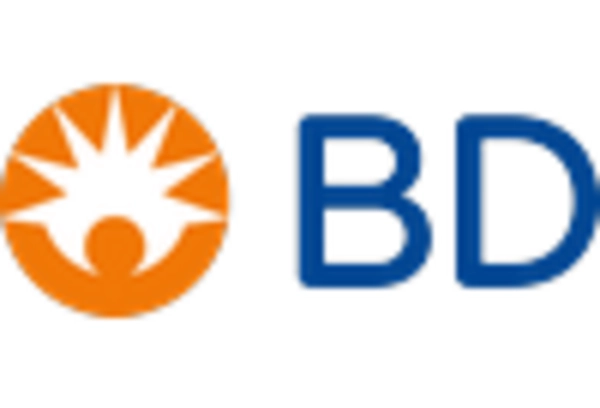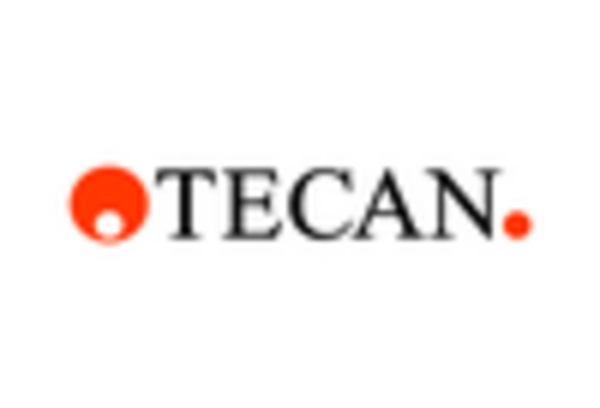Focus on Cost-Effectiveness in Research
The Automated Plate Readers Market is also being driven by a growing focus on cost-effectiveness in research and development. As funding for scientific research becomes more competitive, laboratories are seeking ways to maximize their budgets while maintaining high standards of quality. Automated plate readers offer a solution by reducing labor costs and minimizing the time required for experiments. The market is likely to see an increase in demand as institutions recognize the long-term savings associated with investing in automation technologies. Furthermore, the ability to conduct experiments with fewer resources aligns with the broader trend of sustainability in research practices. This focus on cost-effectiveness is expected to propel the adoption of automated plate readers, as they provide a viable means to enhance operational efficiency without compromising on quality.
Increasing Applications in Drug Discovery
The Automated Plate Readers Market is witnessing a notable increase in applications within drug discovery processes. Pharmaceutical companies are increasingly utilizing these devices to streamline the screening of compounds, which is essential for identifying potential drug candidates. The market for automated plate readers in drug discovery is expected to expand significantly, with estimates suggesting a growth rate of around 9% annually. This growth is attributed to the rising need for efficient and cost-effective solutions in the drug development pipeline. Automated plate readers facilitate high-throughput screening, enabling researchers to analyze thousands of samples simultaneously. As the pharmaceutical sector continues to evolve, the reliance on automated technologies for drug discovery is likely to intensify, further propelling the market forward.
Rising Demand for High-Throughput Screening
The Automated Plate Readers Market is significantly influenced by the rising demand for high-throughput screening (HTS) in various research fields. HTS allows researchers to conduct a large number of tests quickly, which is particularly valuable in genomics, proteomics, and drug discovery. The market for automated plate readers is projected to grow as laboratories increasingly adopt HTS methodologies to enhance productivity and reduce time-to-results. Current estimates indicate that the HTS market could reach a valuation of several billion dollars within the next few years, with automated plate readers playing a pivotal role in this expansion. The ability to process and analyze vast amounts of data efficiently is becoming a critical factor for research institutions, thereby driving the demand for advanced automated plate readers.
Regulatory Support for Automation in Laboratories
The Automated Plate Readers Market is benefiting from increasing regulatory support for the adoption of automation technologies in laboratories. Regulatory bodies are recognizing the importance of automation in enhancing laboratory efficiency and ensuring compliance with quality standards. This support is likely to encourage more laboratories to invest in automated plate readers, as they seek to align with regulatory requirements while improving their operational capabilities. The market is expected to grow as institutions leverage automated solutions to meet stringent regulatory demands, particularly in clinical and pharmaceutical settings. Additionally, the emphasis on data integrity and traceability in laboratory processes further underscores the need for reliable automated systems. As regulatory frameworks evolve, the demand for automated plate readers is anticipated to rise, fostering a more robust market environment.
Technological Advancements in Automated Plate Readers
The Automated Plate Readers Market is experiencing a surge in technological advancements that enhance the efficiency and accuracy of laboratory processes. Innovations such as high-throughput screening and integration with artificial intelligence are transforming traditional methodologies. These advancements allow for faster data acquisition and analysis, which is crucial in research and clinical settings. The market is projected to grow at a compound annual growth rate of approximately 8.5% over the next five years, driven by the need for more sophisticated and reliable testing solutions. Furthermore, the incorporation of automation in laboratory workflows reduces human error, thereby increasing the reliability of results. As laboratories seek to optimize their operations, the demand for advanced automated plate readers is likely to rise, positioning this segment for substantial growth.

















Leave a Comment